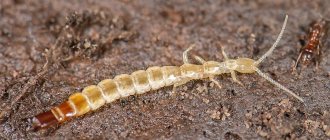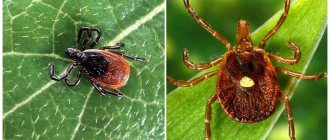What happens if you accidentally eat a tick?
Content
The child ate a tick
The tick population increases in early spring. They wait for their victims in tall grass and at the bottom of trees until the onset of the first cold weather. The probability of meeting one of these during a walk is high even within the city (in a park, square, by the river, on a lawn, etc.).
Unlike a well-fed large tick, a hungry tick is small in size (about 3 mm). Therefore, in theory, an insect could be accidentally swallowed. In this article we will talk about what happens if you eat a tick.
First aid for tick bites
Ticks are small arachnids. They are very small in size and are usually difficult to notice until they are pumped with blood. But then it’s already too late. When a tick lands on a person’s body, it does not immediately dig into his skin, but crawls for a long time, looking for the most delicate places (where the skin is thin). Most often it digs into the groin area, armpits, neck, collarbone area, stomach and back. Its bite is completely insensitive, because the tick's saliva contains an anesthetic substance.
Unlike mosquitoes, which immediately fly away after sucking blood, ticks stick for three to four days. From drinking blood, the ticks swell greatly, increasing in size three to four times, and only then fall off.
Ticks are dangerous not because of their bite, but because they suck blood from various animals, and from each animal they acquire microbes. Then these microbes are introduced into the victim’s blood.
Ticks can transmit not only encephalitis, but also up to 30 other serious diseases. You have become afraid of light. You have become afraid of light.
It is important to know that even if the tick bite was short-lived, the risk of contracting tick-borne infections cannot be ruled out.
When is a tick dangerous?
The tick is most dangerous in the spring-summer period; in August the risk of infection decreases sharply, and in September-October it practically disappears. Ticks are most active in the morning and evening; they love shaded, damp places with dense undergrowth. They usually do not appear in bright places. Ticks love to be near paths where animals (including mice) walk. They love places where cattle graze, various clearings and remote places. In hot weather or rain, ticks hide and do not attack.
Don't forget that ticks crawl from bottom to top. It is a mistaken belief that ticks attack from trees or tall bushes. They lie in wait for their “prey” among the vegetation of the lower tier of the forest (usually no more than 1 m in height). In tall grass, ticks have better protection from sunlight and are more likely to attack.
First aid for a tick bite.
A tick bite is painless, only after a day or two does a feeling of slight nagging pain arise, as a local inflammatory reaction develops at the site of suction, sometimes with suppuration. The bite wound is usually very itchy and heals very slowly.
If you notice a bite, you can remove the tick yourself or seek first aid at an emergency room, clinic, or tick-borne infection prevention center.
How to remove a tick?
You can pull out ticks yourself using tweezers, a loop of strong thread (this method requires skill), or your fingers, preferably disinfected with an alcohol solution. If the tick has already burrowed deeply into the body, you can drip vegetable oil, Vaseline, or something enveloping it and blocking the access of air.
You need to pull out the tick by slightly rocking it from side to side, and then gradually pulling it out. If the proboscis comes off and remains in the skin, then it is removed with a needle heated in a flame and cooled, like a splinter. Even if you do not completely remove the parasite and the proboscis remains under the skin, intoxication with the virus will occur more slowly.
When providing first aid for a tick bite, avoid all contact with the parasite, as the danger of transmission of infection is real and present. Try to prevent the places where the tick has attached itself from coming into contact with the mucous membranes of the eyes, mouth and nose.
What to do with a tick after removal?
It is important to know that in no case should you destroy removed ticks by crushing them with your fingers, since if you accidentally crush a tick, infection can occur as a result of rubbing the infectious agent into the skin or mucous membranes with saliva or tick tissue.
After removing the tick, the suction site should be treated with iodine, brilliant green, or washed thoroughly with soap. The insect itself must be taken for testing to determine if it is infected with tick-borne infections. If you definitely cannot take the tick for analysis, burn it or pour boiling water over it.
A tick analysis is needed for peace of mind in case of a negative result and vigilance in case of a positive result.
Where can I take a tick for analysis?
The tick should be placed in a small glass bottle along with a piece of cotton wool lightly moistened with water. Be sure to close the bottle with a tight lid and store it in the refrigerator. If this is not possible, simply place the tick in a box or wrap it in gauze and try to keep it alive.
The surest way to determine the presence of the disease is to take a blood test. There is no need to donate blood immediately after a tick bite - tests will not show anything. No earlier than 10 days later, you can test your blood for tick-borne encephalitis and borreliosis using the PCR method. Two weeks after a tick bite, test for antibodies (IgM) to the tick-borne encephalitis virus. For antibodies (IgM) to borrelia (tick-borne borreliosis) - after three weeks.
If the tick is infected with Borrelia, then the doctor will prescribe you antibacterial drugs to prevent the development of borreliosis. If it is a tick-borne encephalitis virus, you will be advised to administer immunoglobulin against tick-borne encephalitis (it contains ready-made antibodies) during the first 4 days after the bite. The administration of immunoglobulin significantly reduces the likelihood of the disease occurring, but cannot eliminate it completely. Therefore, doctors will monitor your health for 2 weeks.
Prevention of tick bites
One of the means of preventing tick-borne encephalitis is vaccination. If the regimen is followed, diseases are extremely rare and, as a rule, occur in a mild form. However, vaccinations must be done on time - several months before the start of the season or before the intended walk through the forests. This is exactly how long it takes for the body to “accumulate” a sufficient number of antibodies to infections and bring the immune system into full combat readiness. There is a so-called emergency vaccination, but its effect will not come immediately either - after a month and a half. That is, if you take injections in May, then by mid-July you will “accumulate immunity.” It should be borne in mind that the vaccine only protects against tick-borne encephalitis.
To prevent tick bites, it is usually recommended to wear specially selected clothing for hiking in the forest that protects most of the body and fits tightly to shoes and wrists so that ticks cannot crawl under it. A hood or other head covering is desirable on the head (for example, a scarf, the ends of which should be tucked under the collar). It is better that the clothes are light and plain, as ticks are more noticeable on them. Wearing overalls is really effective, but in the summer they are hot. Still, to prevent tick bites, it is important to try to wear clothing that is as closed as possible.
There are many insect repellent products on the market now. You need to make it a rule when going into the forest to use repellents that say “against ticks”; mosquito repellents are not effective.
The most important thing is to try to prevent ticks from being sucked on. It is important to remember that the tick sticks tightly 1-1.5 hours after it hits the body.
When walking along a forest road, do not tear off branches or deliberately pull them back. With this action, you shake off the largest number of ticks on yourself and on the person passing behind you.
After a walk, be sure to carefully examine yourself, because a tick bite, especially a male one, may not be felt or may be confused with a mosquito.
Symptoms that require you to see a doctor!
If after being bitten you:
— A rash has appeared on the body — A red spot has formed at the site of the bite wound — The temperature has increased — Aches in the muscles and joints have appeared — You have become afraid of light
Contact your doctor immediately!
Under what circumstances can this happen?
Ticks are not picky about their habitat. This is especially noticeable in the spring-autumn period. Anything with tall plants, heaps of grass, foliage, etc. is suitable for them. Since they feed exclusively on the blood of warm-blooded animals and birds, ticks are able to wait for their owner for weeks, or even months. They identify a new victim by smell and do not lose the opportunity to feast on blood.
meet a tick anywhere:
- on the river;
- In the woods;
- in the park;
- in the garden;
- in the car.
Therefore, on such walks we recommend wearing the most closed clothing possible.
For the first couple of minutes, the parasite remains on the clothing without moving, then it begins to follow in search of open areas of the body. Once a tick has gained access to the body, it will look for a place with thin skin (armpits, groin, arms, back, neck). The tick does not come close to the face, so the likelihood of ingestion is extremely low.
This can only happen by chance. For example, when a pest chose a place to live in a bush with berries. This way you can accidentally eat an insect and not notice it.
In the next article we will tell you: Will parks be treated against ticks in Moscow in 2022?
Treatment of the wound
After removing the tick, the parasite bite site should be treated. For this purpose, use alcohol or other disinfectant available on hand. Iodine and hydrogen peroxide will do.
When going for a walk in a forested area, do not forget about the danger of tick attacks. It is recommended to always have with you basic tools that may come in handy. Everything you need is available freely in pharmacies.
Removing ticks from dogs
On a note!
This method is not suitable for removing ticks from pets. This is due to the fact that the pet’s fur will not allow the necessary pressure to be created.
Veterinary clinics sell special devices in the form of a curved hook with a slot for removing ticks from animals. Or you can use tweezers. Animals' wounds should also be treated.
What happens if you eat an encephalitis tick?
Every year, with the onset of warm weather, the media broadcast information about the threat of infection with the encephalitis virus from a tick bite.
- The pathogen enters the human body through an insect bite or when the tick is carelessly removed from the skin. Then parts of the parasite’s body remain under the person’s skin, and its blood will definitely enter the person’s blood. The virus eventually enters the bloodstream, affecting the central nervous system and blood vessels.
- In particularly difficult cases, paralysis, dementia, and even death can occur. The incubation period of the disease is 2 weeks. The difficulty lies in the fact that it cannot be determined before the first signs. In addition, at first encephalitis is confused with a common cold.
- The main fear of people who have swallowed a tick is infection with encephalitis. If you eat a live and whole parasite, nothing will happen. The insect will quickly enter the stomach and be digested there. If you chew a tick before swallowing, the possibility of becoming infected increases.
How to pull out a tick
If the attached insect was found in the forest, far from civilization, then you can eliminate the tick on your own. It must be remembered that any careless movement can lead to rupture of the insect, and if the head of the tick remains in the body, then this is very dangerous.
To properly remove a blood-sucking parasite, it is recommended to resort to one of the following methods:
1. Using tweezers (tweezers) . The instrument is treated with any antiseptic (you can use vodka) or heated over a fire. Using sterile forceps, carefully grasp the tick as close to the surface of the human body as possible. You should not grab the parasite by the abdomen, as it will easily come off the head. Having captured the “bloodsucker”, they begin slow rotational movements counterclockwise, trying to “unscrew” the tick.
2. Using thread . If you don’t have tweezers or forceps at hand, you can resort to using regular thread. Make a small loop. This “lasso” is thrown over the tick, trying to move it as close to the body as possible. Lightly tighten the loop, securing the insect. Then they begin to slowly twist the bloodsucker in the opposite direction clockwise.
3. Manual method . This is the most dangerous method. Since ticks can serve as a carrier of infection, it is necessary to protect yourself as much as possible from the risk of infection. Therefore, it is recommended to wear gloves or protect your fingers with gauze when removing the parasite. The insect is grabbed with the nails right next to the victim’s skin and gently twisted. It is important not to crush the tick.
After pulling out an insect, many people make a colossal mistake. They simply throw away the parasite. In the future, they are very worried whether the tick was infected. To protect yourself from such experiences, the elongated insect must be preserved (in an ordinary jar with a lid) and delivered for research. The analysis will take 1-2 days.
What to do if you accidentally ate a tick
First you need to calm down. If you swallow a whole and living insect, then do not panic. You can simply forget about this trouble and live a calm life. But for prevention, you can rinse your stomach. This way you will get 100% confidence, reassure both yourself and your loved ones. To do this, you need to drink a large amount of water and induce vomiting.
The likelihood of contracting encephalitis due to tick ingestion is extremely low. This is rather possible in theory, but in practice such cases have not been registered in world medicine.
Where and when can you find a tick?
Like all arachnids, ticks do not have wings. These parasites do not have eyes, so they navigate in space using their sense of smell. They can sense a potential object 10 m away. Ticks are found in areas where there is no loud noise and a lot of bushes.
Wet, shaded areas of forests, undergrowth with thick grass, and meadows on the shores of lakes are favorite habitats for ticks. As a rule, parasites jump onto a person from below. Important! Keep in mind that ticks cannot be found on trees; they jump from below, not above.
With the arrival of warm days, females need to ensure the maturation of eggs, and for this they need animal or human blood. Particular activity of ticks is observed from April to July in the morning and evening. During the day, when it is very hot, the parasites hide from the sun and do not pose a strong danger. Ticks are not very mobile. Throughout its entire life, each tick moves no more than 10-15 m. In anticipation of prey, they sit on branches no more than 1.5 m from the ground. When a person or animal walks by, the tick smells it and, straightening its legs, catching the direction with this organ of smell, jumps towards it.
It is worth knowing that ticks do not distinguish between the type of forest; it is important for them to find a comfortable habitat. Tick larvae live on small rodents that live in forests until they become adults. But where there are many anthills, you may not find a single parasite. Ants happily eat ticks even at the larval stage.
Correct ways to remove ticks
There are special devices to make it easier to remove the bloodsucker from the skin. These are all kinds of grippers, tweezers and tweezers.
How to remove an X-shaped tick from a person
Regular tweezers will do. The bloodsucker needs to be grabbed by the neck as close to the body as possible and pulled up. There are special grips and tweezers that are sold in pharmacies. They are the easiest way to get a “vampire”.
If you don’t have tweezers, you can try to pull out the tick using ordinary tape. Stick it to the place where the parasite got in and pull it back. The bloodsucker should stick to the tape and pull out.
You can try to pull out the bloodsucker using regular thread. Place a loop around the parasite's neck and slowly pull it perpendicularly upward. Make sure that the loop does not tighten on the belly.
The tick's head remains under the skin: what to do
The most pathogenic microbes are located in the belly of the flare, so if you pulled it out and the head remained in the skin, it’s okay. It can be pulled out like an ordinary splinter.
- Disinfect the needle and pick at the bite site to remove the head of the parasite.
- Even if this is not done, nothing terrible will happen; perhaps in a few days his head will “come out” on its own.
How not to pull out a tick
Among the people, there are quite risky ways to remove a bloodsucker. It is believed that something unpleasant should be poured on it:
- petrol;
- nail polish;
- nail polish remover;
- any fat.
This strategy is considered incorrect by experts. In this case, the parasite will not fall off anywhere, but it will inject its victim with dangerous toxins, and at the same time infectious agents.
What is Demodicosis
Demodex (Demodex spp.) is a parasitic mite that causes a disease called demodicosis. It is found not only in humans, but also in animals, for example, demodex in dogs.
Human skin is most often colonized by Demodex folliculorum.
This parasite feeds on the sebaceous glands of the skin and hair follicles, feeding on lipids and epidermal cells. It is estimated that 60% of adults and 90% of older people are carriers.
Demodicosis in humans.
Causes, symptoms, treatment and possible complications of the disease
| Routes of infection | Infection with Demodex occurs through contact with the host's skin or objects that he has used, for example, clothing, towels, bed linen, and cosmetics. Demodex also moves along with the dust. You can become infected with it, for example, in a hairdresser or beauty salon, as well as in a pharmacy when using testers. However, humans cannot become infected from animals, since demodex is specific to this species. |
| Symptoms and pathologies | Simply finding demodex on the skin is not the same as demodicosis. Only pathological reproduction of this parasite causes symptoms of the disease. A favorable condition for this is a decrease in the body's immunity. |
| Risk area | This is why demodex is more common among allergy sufferers, diabetics, elderly people, and people living in constant stress. The eyes, facial skin, or scalp may be affected, depending on the areas affected by Demodex. Because symptoms vary in severity, they are sometimes confused with other diseases. |
| Use of antibiotics | Because of bacterial superinfections with staphylococci and streptococci favored by Demodex, treatment often involves the administration of antibiotics. However, the parasite itself is resistant to them, so it cannot be treated with oral antibiotics. |
| Local therapy | Thus, local treatment is carried out, for example, with ivermectin preparations. It is an antiparasitic and anti-inflammatory agent. Creams and ointments with metronidazole or azelaic acid are also used. |
| Features of treatment | Treatment time lasts from several weeks to several months, since the drugs act only on adult forms of demodex. The only way out is to be patient and constantly follow the prescribed treatment. In this case, it is necessary to strictly observe the hygiene regime and properly care for the skin. |
What is the danger of ticks penetrating the skin?
A large number of parasites live on human skin. Scabies mites and demodexes live under the skin. The latter are opportunistic. They begin to actively multiply when human immunity decreases.
Preventive measures against ticks
- Before a walk in the forest or park, you must wear clothes and shoes that will fully protect your body, covering your ankles, ankles, neck, and wrists.
- You also need a hat or hood.
- You can use special repellent sprays or creams.
Previous
TicksHow a tick breathes during a bite, or how little “vampires” manage not to suffocate during a meal
Next
Ticks Should you be afraid if a tick crawls across your body: what can be dangerous walking for “bloodsuckers”











